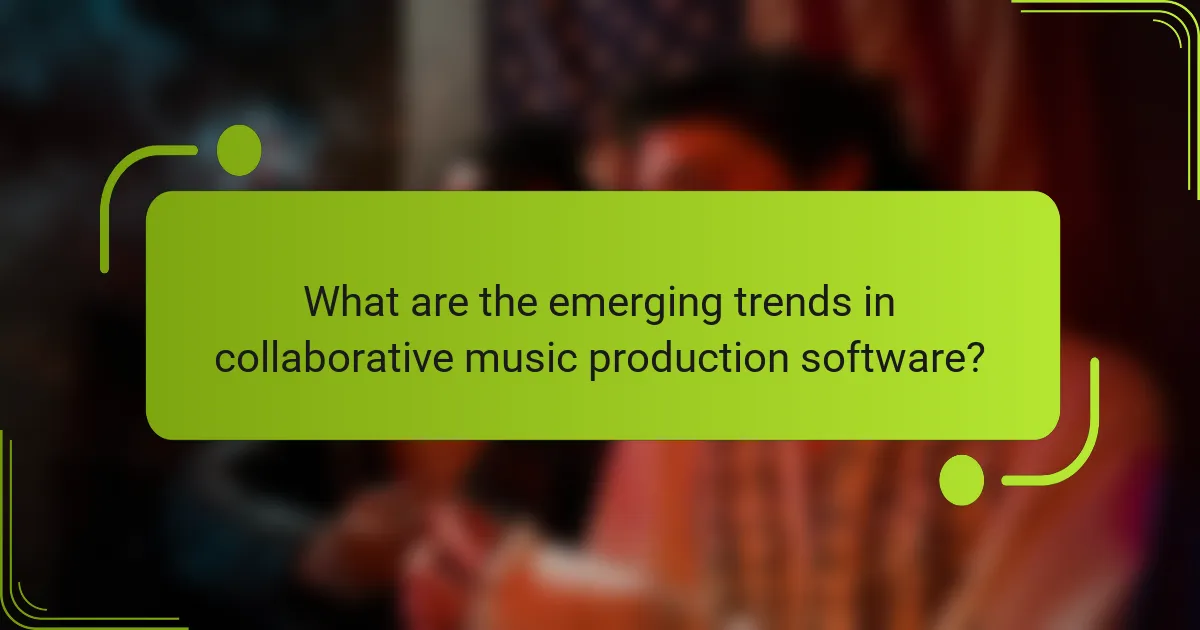Choosing the right music production software for collaborative work is essential for fostering creativity and efficiency among team members. Key features to look for include real-time collaboration capabilities, ease of file sharing, and effective communication tools. Additionally, factors such as compatibility with operating systems, supported file formats, and user-friendly interfaces play a crucial role in ensuring a seamless collaborative experience.

What are the best music production softwares for collaboration?
The best music production software for collaboration allows multiple users to work on projects simultaneously, share files easily, and communicate effectively. Key options include Ableton Live, Logic Pro X, FL Studio, Pro Tools, and Studio One, each offering unique features tailored for collaborative workflows.
Ableton Live
Ableton Live is renowned for its intuitive interface and real-time collaboration capabilities. It supports features like Link, which synchronizes tempo across devices, making it easy for multiple users to jam together remotely.
When using Ableton Live for collaboration, consider utilizing its Session View for improvisation and quick arrangement. This can help streamline the creative process, allowing collaborators to experiment with ideas without the constraints of a linear timeline.
Logic Pro X
Logic Pro X is a powerful tool for Mac users, offering robust features for music production and collaboration. Its built-in tools for sharing projects via iCloud make it convenient for teams to access and edit files from different locations.
To maximize collaboration in Logic Pro X, take advantage of its Track Stacks and Smart Controls. These features help organize complex projects and allow collaborators to focus on specific sections without getting overwhelmed.
FL Studio
FL Studio is popular for its user-friendly interface and extensive plugin support, making it suitable for collaborative music production. Its cloud integration allows users to share projects easily, ensuring everyone has access to the latest version.
When collaborating in FL Studio, consider using the Playlist feature to arrange and edit tracks collaboratively. This visual approach can help teams quickly identify areas for improvement and make adjustments in real time.
Pro Tools
Pro Tools is often considered the industry standard for audio editing and mixing, making it a top choice for professional collaborations. Its cloud-based features enable seamless sharing of sessions and files, facilitating teamwork across distances.
For effective collaboration in Pro Tools, utilize its Avid Cloud Collaboration feature. This allows multiple users to work on the same session simultaneously, with changes automatically synced, reducing the risk of version conflicts.
Studio One
Studio One offers a streamlined workflow and is designed with collaboration in mind. Its integrated cloud services allow users to share projects and collaborate in real time, making it ideal for teams working remotely.
To enhance collaborative efforts in Studio One, use its Scratch Pad feature to test out different ideas without altering the main project. This allows collaborators to experiment freely while keeping the original work intact.

How do collaboration features impact music production software?
Collaboration features significantly enhance music production software by enabling multiple users to work together seamlessly. These tools facilitate real-time interaction, shared resources, and coordinated workflows, which are essential for effective teamwork in music creation.
Real-time editing
Real-time editing allows multiple users to make changes to a project simultaneously, which can streamline the creative process. This feature is particularly useful during brainstorming sessions or when quick adjustments are needed, as it minimizes the back-and-forth typically associated with collaborative work.
When selecting software, look for platforms that support low-latency editing, ensuring that changes appear instantly for all users. Popular options like Ableton Live and Logic Pro X offer this capability, making them ideal for collaborative environments.
Cloud storage integration
Cloud storage integration is crucial for collaborative music production, as it enables easy access to projects from anywhere. This feature ensures that all collaborators can retrieve the latest versions of files without the hassle of manual transfers or version control issues.
Consider software that offers seamless integration with cloud services like Google Drive or Dropbox. This allows for automatic backups and file sharing, reducing the risk of data loss and ensuring that all team members are working with the most current materials.
Multi-user access
Multi-user access is a fundamental feature that allows several individuals to work on a project at the same time. This capability can enhance creativity and efficiency, as different perspectives and skills can be applied simultaneously to various aspects of the music production process.
When evaluating music production software, check for user limits and permissions settings. Some platforms may allow unlimited users, while others may have restrictions. Choose software that aligns with your team’s size and collaborative needs to maximize productivity.

What criteria should you consider when selecting music production software?
When selecting music production software for collaborative work, consider factors such as compatibility with operating systems, supported file formats, user interface, and pricing models. These criteria will help ensure a smooth workflow and effective collaboration among team members.
Compatibility with operating systems
Ensure that the music production software is compatible with the operating systems used by all collaborators. Most software supports major platforms like Windows and macOS, but some may also offer versions for Linux or mobile devices.
Check for any specific system requirements, such as processor speed, RAM, and available storage. This will help avoid performance issues during collaborative sessions.
Supported file formats
Verify that the software supports the audio file formats you and your collaborators commonly use, such as WAV, MP3, or AIFF. Compatibility with MIDI files is also crucial for projects involving virtual instruments.
Some software may offer proprietary formats that can limit sharing. Choose options that allow for easy export and import to facilitate collaboration.
User interface and experience
A user-friendly interface can significantly enhance collaboration by reducing the learning curve for new users. Look for software that offers intuitive navigation and customizable layouts to suit different workflows.
Consider the availability of tutorials and community support, as these resources can help team members quickly adapt to the software and resolve any issues that arise during collaboration.
Pricing models
Evaluate the pricing models of the music production software, as they can vary widely from one-time purchases to subscription-based services. Subscription models may offer regular updates and cloud storage, which can be beneficial for collaborative projects.
Compare the costs against the features offered to determine the best value. Some software may offer free trials or tiered pricing, allowing you to test functionality before committing to a purchase.

How does software pricing affect collaborative music production?
Software pricing significantly impacts collaborative music production by influencing accessibility and team dynamics. Budget constraints can limit options, affecting the choice of tools that facilitate effective collaboration among team members.
Subscription vs. one-time payment
Choosing between subscription and one-time payment models is crucial for collaborative music production. Subscription services typically offer regular updates and cloud features, enhancing teamwork, while one-time payments may provide a more stable long-term cost but lack ongoing support.
For teams, subscriptions can range from $10 to $50 per month, allowing flexibility in budgeting. However, if a team plans to use the software long-term, a one-time payment option, often between $200 and $600, might be more economical.
Free trial availability
Free trials are essential for evaluating software before committing to a purchase. They allow teams to test collaborative features and compatibility with existing workflows without financial risk.
Many software providers offer trials lasting from 7 to 30 days. Teams should take advantage of these periods to assess usability and collaboration tools, ensuring they meet their specific needs.
Cost of additional features
Understanding the cost of additional features is vital for budgeting in collaborative music production. Many software platforms offer basic packages but charge extra for advanced tools, plugins, or cloud storage.
Teams should consider whether the additional costs, which can range from $50 to several hundred dollars, align with their collaborative goals. It’s often more cost-effective to choose a software that includes essential features upfront rather than paying for add-ons later.

What are the prerequisites for effective collaborative music production?
Effective collaborative music production requires a combination of technical infrastructure, knowledge, and communication skills. Key prerequisites include a stable internet connection, compatible hardware, and a foundational understanding of music theory.
Stable internet connection
A reliable internet connection is essential for seamless collaboration in music production. It ensures that all participants can share files, communicate in real-time, and access cloud-based tools without interruptions.
For optimal performance, aim for a connection speed of at least 10 Mbps for uploads and downloads. This helps prevent latency issues and allows for smooth streaming of audio and video during sessions.
Compatible hardware
All collaborators should use hardware that meets the requirements of the chosen music production software. This includes having sufficient processing power, RAM, and storage space to handle large audio files and complex projects.
Consider using devices that support the latest operating systems and audio interfaces. For example, a computer with at least 8 GB of RAM and a multi-core processor is recommended for efficient music production.
Basic music theory knowledge
A foundational understanding of music theory enhances collaboration by enabling all participants to communicate effectively about musical ideas. Familiarity with concepts such as scales, chords, and rhythm can significantly improve the creative process.
Collaborators should be comfortable discussing musical elements like key signatures and time signatures. This shared knowledge allows for more productive discussions and helps streamline the decision-making process during production sessions.

What are the emerging trends in collaborative music production software?
Emerging trends in collaborative music production software focus on enhancing real-time interaction, cloud integration, and user-friendly interfaces. These advancements allow musicians and producers to work together seamlessly, regardless of their physical locations.
Real-time Collaboration Features
Real-time collaboration features enable multiple users to work on the same project simultaneously, facilitating instant feedback and creativity. Software like Soundtrap and BandLab exemplifies this trend, allowing users to see changes made by others in real-time. This immediacy can significantly enhance the creative process, making it more dynamic and engaging.
When selecting software, consider latency and connection stability, as these factors can impact the quality of collaboration. Aim for platforms that offer low-latency performance, ideally under 20 milliseconds, to ensure a smooth experience.
Cloud-Based Solutions
Cloud-based solutions are becoming increasingly popular in music production, allowing users to store and access their projects from anywhere. This flexibility is crucial for collaborative work, as it eliminates the need for physical storage devices and enables easy sharing of large files. Services like Splice and Avid Cloud Collaboration are leading the way in this area.
When choosing a cloud-based platform, evaluate storage options and subscription costs. Many services offer tiered pricing, so consider your team’s needs, such as the number of collaborators and the amount of storage required.
User-Friendly Interfaces
User-friendly interfaces are essential for collaborative music production software, as they lower the barrier to entry for less experienced users. Intuitive designs help streamline workflows and make it easier for teams to communicate ideas. Software like GarageBand and FL Studio is known for their accessible interfaces.
Prioritize platforms that offer tutorials and community support to assist users in navigating the software. A strong support system can enhance collaboration by ensuring all team members are comfortable with the tools at hand.


